Latest postings
-
October 16, 2021
Which way is your Pegasus leaping?
Roadside
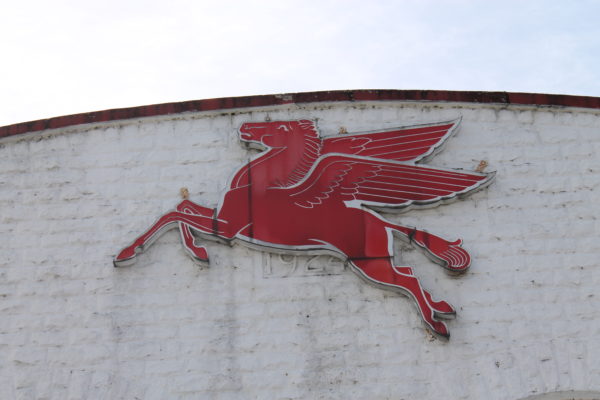
The red Pegasus has been the logo of Mobil, and before that Mobilgas and SOCONY, going back to 1931. The company itself is even older, tracing its origins to the Vacuum Oil Company of Rochester, NY, founded in 1866. Like so many oil companies of the early petroleum era, Vacuum Oil found its way into the Standard Oil empire of John D. Rockefeller. After the Standard Oil Trust was broken up in 1911, Vacuum Oil became independent again and the New York regional interests of Standard Oil became SOCONY – the Standard Oil Company of New York.
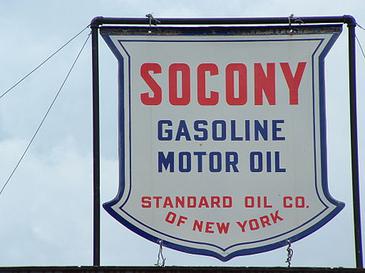
Then, in 1931, SOCONY and Vacuum Oil merged back together, after the government gave up trying to prevent it. The Socony Vacuum Oil Company adopted the red Pegasus as its trademark that year. The image of a flying horse was a powerful one in an era when horses were still remembered as a primary form of transportation, and gasoline engines were so powerful by comparison it almost seemed as though a horse could fly.
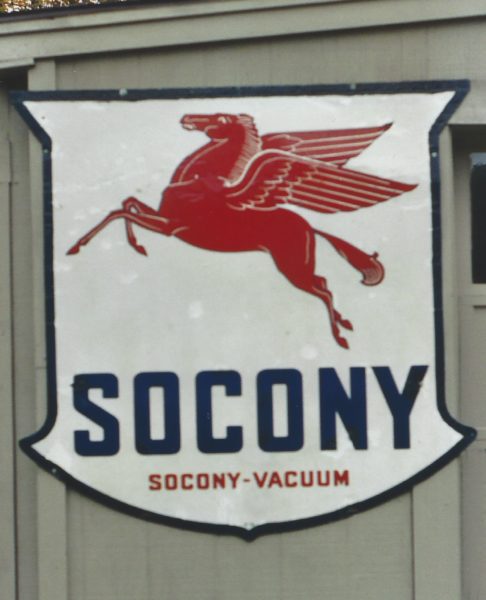
The name SOCONY would prove problematic for a company distributing its products nationally, however. As part of the 1911 Standard Oil breakup, use of the name Standard Oil – or any variation thereof – could be challenged by other Standard Oils in their home territory. This is precisely why Midwest Standard stations (Standard Oil of Indiana) were known as Amoco in the East, and why Esso – phonetically S. O. for Standard Oil – would eventually rename itself Exxon.
For Socony Vacuum (which also included regional companies Magnolia Petroleum in Texas and General Petroleum in California), the answer came in their brand names, Mobilgas and Mobiloil. Mobilgas – still paired with the red Pegasus – became the dominant name on the sign, with a smaller “Socony – Vacuum” underneath.
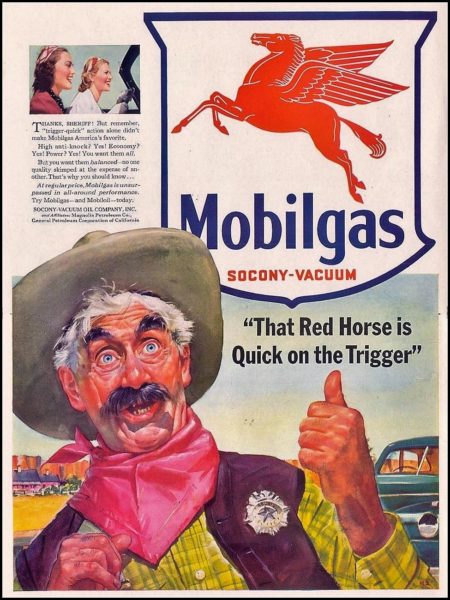
The corporate name and image would continue to evolve, becoming Socony Mobil Oil Company in 1956, with a new station sign that would have an especially short lifespan – only 10 years.
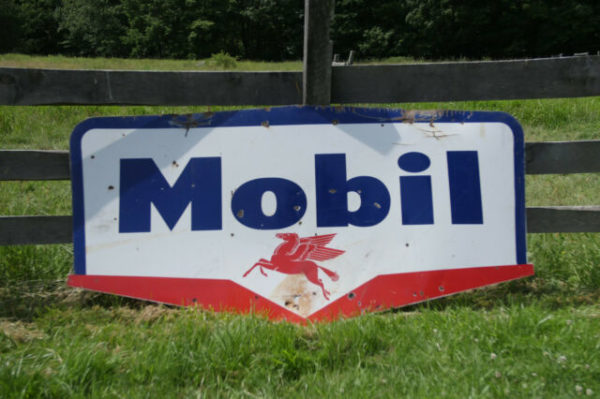
Then, in 1966, Mobil Oil Company celebrated its centennial, dated from the founding of Vacuum Oil in 1866, even though neither Socony nor Vacuum were part of the newly streamlined company name. It was time for a brand refresh:
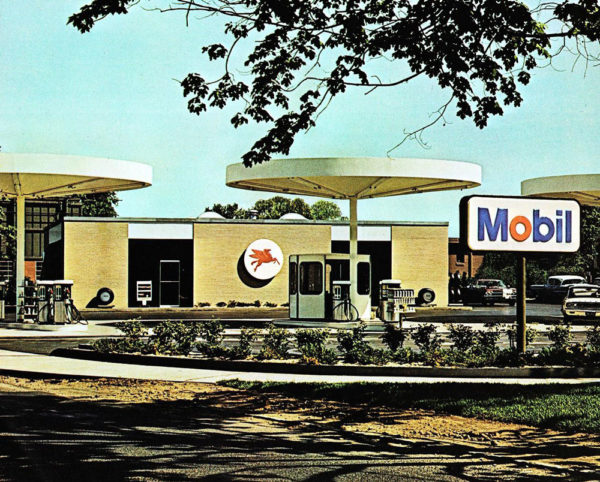
Chermayeff & Geismar.
Architect and industrial designer Eliot Noyes led a near total redesign of Mobil station imagery. The new gasoline pumps were sleek cylindrical affairs with circular lighted canopies overhead. The new station sign featured a red o in Mobil, a now familiar trademark for 50-plus years.
One trademark was carried over nearly intact – the red Pegasus. However, after 35 years of leaping to the left, the image was mirrored so it is now leaping to the right.
Why was this done? I heard one report that the Pegasus was now leaping into the future.
-
January 1, 2019
2018 in review: “Everything ends”
Roadside
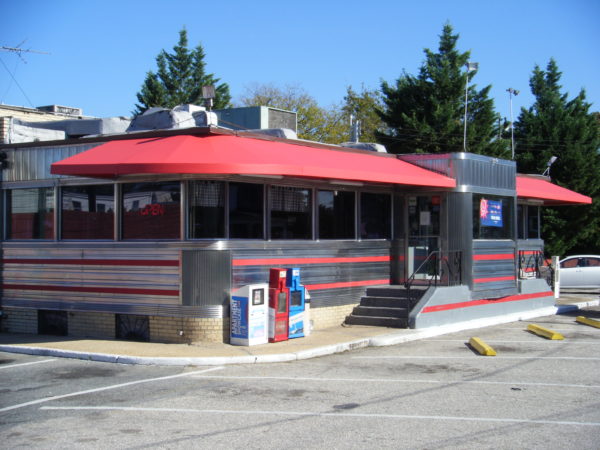
Tastee Diner, Laurel, Maryland. 2014 photo by Glenn Wells
On November 10, 2018, Spencer Stewart broke the news to the diner community that big changes were in store for the Tastee Diner in Laurel, Maryland. This rare Comac diner, one of only two operating, would be gutted, covered with a new facade, and converted to a medical marijuana dispensary. The bad news spread throughout the diner community, and a “Save the diner” movement was not far behind. Supporters of the diner were granted a major victory December 11 when the Laurel Planning Commission voted unanimously against granting the permit the dispensary would need.
The Washington Post reported, ” After the vote, supporters went to the diner for celebratory beers and grilled cheese sandwiches. There were high-fives, hugs and smiles. ”
But that same article contained another ominous quote, one that casts doubt on the diner’s future. Gene Wilkes, who has owned the diner since the 1970s and operates two other Tastee Diners in Bethesda and Silver Spring, indicated it was time to cut back and the Laurel diner might not have a future.
“I’m 75,” he said. “Everything ends.”
Everything ends. A simple truth of life, if not always a happy one.
I then looked back over all the roadside news from the past year posted on the RoadsideFans Facebook page and noticed a large number of endings for the year:
The Ben Franklin variety store in Middlebury, VT closed last summer. Once a staple of every downtown, the classic five and dime can now only be found in isolated, independently run stores, such as Sine’s 5 & 10 in Quakertown, PA or the Northville 5 & 10 in Northville, NY.
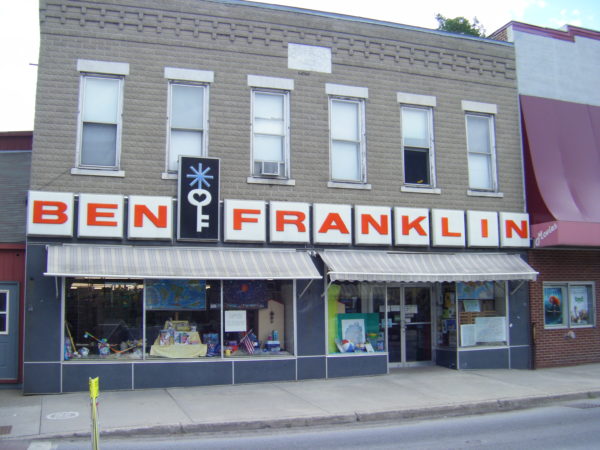
Ben Franklin, Middlebury, Vermont 2012 photo by Glenn Wells
Lombardo’s Restaurant in Albany, NY, after operating nearly a century, served its last Italian dinner New Year’s Eve. Its vintage multi-story neon sign is certain to attract the notice of collectors, but the interior, as Albany resident and longtime RoadsideFan Eric Stott notes, is “a flawless piece from the tin ceiling with deco light fixtures, down to the murals and booths, to the tiled floor. The stained glass beer signs in the window must be worth a small fortune. The whole space should be in the state museum as a prime example of an early 20th Century Italian restaurant. A New York City decorator would pay a fortune to recreate the ambience.”
O’s Eatery along the Taconic Parkway in Chatham, NY was destroyed by fire December 8. This was a 1963 Fodero, the third of the four Chief Taghkanic diners installed along the Parkway by Burt Coons. Its Space Age styling with Western style wagon wheel light fixtures overhead represented an era in diner style never to be seen again.
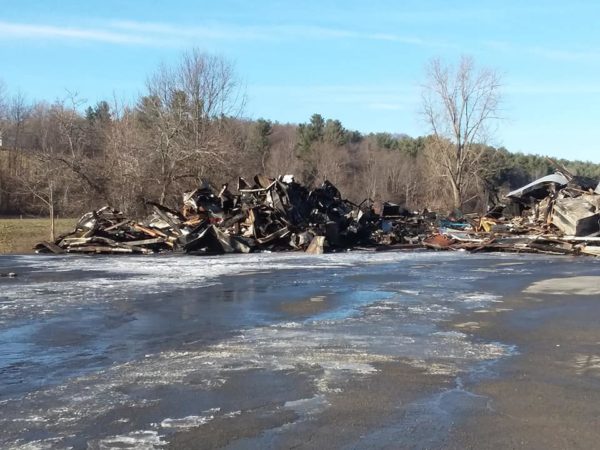
All that remains of O’s Eatery. Photo by Bob Butler
Fat Boy Drive-In in Brunswick, Maine is for sale. Just down the road from the vintage Ernie’s Drive-In (now Cameron’s Lobster House), two operating carhop drive-ins so close together were a delight to see on our visit in 1999.
Ye Olde College Diner in State College, PA has closed and will be replaced with Hello Bistro, operated by the Eat N Park chain. This will upset generations of Penn State alumni, but indications are today’s young people don’t go to diners the way their parents and grandparents did.
ChesDel Restaurant in Middletown, Delaware, two vintage diners joined in an L shape, closed last February. What started as a temporary closure to repair a water heater soon became permanent and the equipment was auctioned in May.
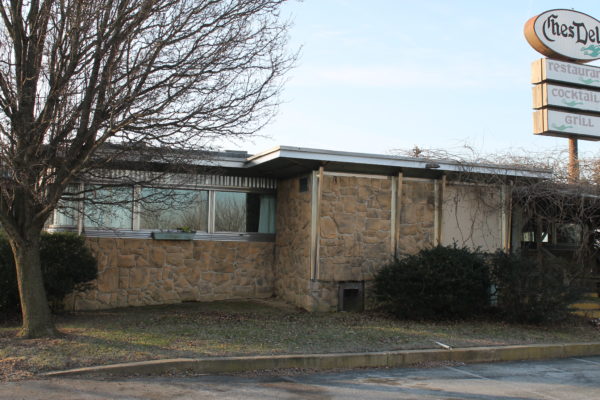
ChesDel Restaurant 2017 photo by Glenn Wells
Potato City Motor Inn, a 1949 Streamline Moderne structure featured in Rick Sebak’s “Pennsylvania Diners and Other Roadside Restaurants,” was demolished.
Water Slide World in Lake George, NY, a family run water park, did not open due to the death of his owner, who was the only person holding the necessary certifications. His widow originally planned to reopen, but soon enough its parcel was advertised as “12 Prime Commercial Acres for Re-Development.”
In New Jersey, the Egg Platter Diner in Paterson (Master) and the Circus Drive-In in Wall were both demolished.
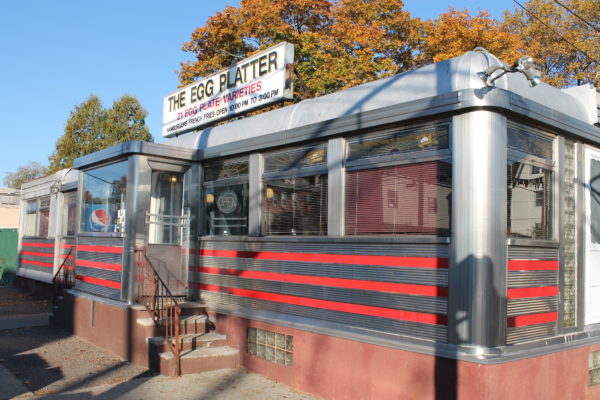
Egg Platter Diner 2016 photo by Glenn Wells
Bowl O Mat in Beverly, MA, a candlepin bowling center, closed and its contents were sold – right down to the hardwood lanes.
Rising property values forced out more diners in the New York City area, including the Shalimar Diner in Rego Park and the Flagship Diner in Queens. Goodfellas Diner in Queens closed after a fire last June, and while the DeRaffele diner is still there, it’s boarded up.
Yankee Diner in Charlton, MA is “Permanently Closed” according to Google, but at least while this vintage Worcester Lunch Car remains in place, there’s hope someone will reopen it.
The moral of this story: Get out and visit, patronize, and photograph vintage places while they are still around. Everything ends.
-
September 18, 2016
Get ready for “Open road tolling”
Roadside
UPDATE: On my most recent Florida car rental, from Hertz, the rental car did not have a transponder with the ON / OFF switch and instead used PlatePass to track tolls. When I tried to register the car with Toll By Plate as described below, I was told I could not. PlatePass caps your charge at “only” $24.75 – for a single $1.50 toll out of a one week rental. If you think you’re avoiding pitfalls by using Hertz – the traditional “# 1” car rental company – think again.
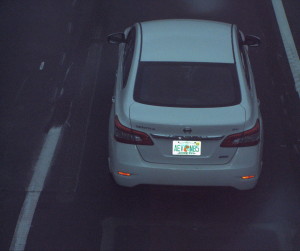
Photo of a rental car taken from a Florida overhead toll gantry with the license number clearly visible. The owner of the car (you or the rental company) later receives a bill, unless you arrange to pay the bill online.
Say goodbye to the toll booth. Say hello to open road tolling.
In Florida, it’s already here. Massachusetts will convert the Massachusetts Turnpike on October 28, 2016. And Ohio may be next.
Toll roads, of course, have been around for decades, and so too has the familiar toll booth, with a person inside who collects your money and gives you change. This basic arrangement remained unchanged until the 1990s, when electronic tolling systems were introduced, initially to relieve congestion on some of the busiest toll roads and bridges in the Northeast. Electronic tolling enables motorists to drive through the toll lanes without stopping, so long as they have a toll account and a transponder affixed to their windshield.
E-Z Pass is the largest system of this type, encompassing 38 agencies across 16 states, concentrated in the Northeast where most of the toll roads and bridges are located. Three Southeastern states have their own electronic toll collection systems, all incompatible with E-Z Pass: South Carolina (Palmetto Pass), Georgia (Peach Pass), and Florida (Sunpass).
Initially, electronic tolling used existing conventional toll lanes. As its popularity grew, especially in congested metropolitan areas, it became more common to see only one or two cash lanes, with the rest being electronic only. There was also grumbling from motorists about needing to slow down to 5 or 10 miles per hour (in a lane where formerly they would need to stop.) Because the slower speed was for the safety of the toll workers, not any technical requirement, some plazas were redesigned to allow electronic toll customers to drive at faster speeds.
This evolved into “open road tolling” where motorists stay on the highway mainline and need not slow down at all. The toll plaza on the New Hampshire Turnpike and the Woodbury plaza on the New York Thruway were rebuilt to take advantage of this, relieving long-standing traffic bottlenecks in the process. E-Z Pass customers stay to the left, maintaining 65 MPH speed, while cash customers stay to the right and stop at traditional toll booths. The tolling electronics are placed in overhead gantries, along with a system that photographs license plates, originally intended to catch scofflaws driving through without paying.
So that brings us to the present day and the latest toll road trend – the completely cashless open road tolling system where there are no toll booths at all and no option for paying a cash toll on the spot. Cars without a toll transponder receive a bill in the mail, sent to the registered owner of the car whose license plate was photographed (which tends to be slightly higher than an electronically collected toll.)
All electronic tolling certainly has a number of advantages, especially in congested areas. There’s no slowing down for the toll booth, no weaving to get into the proper toll lane (cash or electronic), and no fumbling for change. Everybody wins, right?
That may be true if you are driving your own car. But with a rental car, things get more complicated and potentially much more expensive.
On two recent Florida trips, my rental car came with its own SunPass, with an ON / OFF switch. Once you turn it ON and drive through an electronic toll barrier, you are agreeing to the rental company’s terms and conditions for using it. But read the rental contract very carefully – some charge an extra $4 a day for the entire length of the rental regardless of how much the SunPass is used. Thus, for a two week rental, a single $1 toll could cost you $56!
Therefore, if your rental car has a toll transponder with an ON / OFF switch, make certain it is turned OFF and leave it OFF for the entire period you have the car. (And check the wording on the switch very carefully – on my rental car, ON was down and OFF was up – backwards from a conventional light switch.)
But if you do nothing else and drive on roads using Toll By Plate, your outcome may be even worse. The signs may boast “We bill you with Toll By Plate” but remember those bills will go to the registered owner of the car, which is the rental company, not you. Expect a bill from the rental company with a substantial service charge tacked on – after all, the rental company expects you to use their transponder for $4 a day.
The answer is, you must pay your own tolls yourself and leave the rental company out of it. Fortunately, there are two ways you can do this:
1. Use your own transponder. If you don’t already have one, you can get one through any of the agencies issuing them – you need not be a resident of that state. (And remember South Carolina, Georgia, and Florida are not E-Z Pass states, so you will need to get a SunPass when visiting Florida, for example.)
2. Establish your own Toll-By-Plate account. We used this technique successfully on two Florida trips. Once you reach your hotel or some other place where you can safely go online, enter the license plate number from your rental car into your account with the dates of your rental. Most toll roads offer you a grace period, so you can backdate the starting date even if you have already incurred a toll. You will probably need to fund this account by means of a credit card, but this will enable you to pay your own tolls yourself, at the Toll-By-Plate rate, and leave the rental company out of it.
Looking ahead, it’s clear that open road tolling is here to stay. But because people can no longer “opt out” by paying a cash toll (unless they avoid the toll road completely, which often is not practical) a couple of changes are in order:
1. A national toll system where any transponder is universally accepted by all toll roads and bridges. A good step in this direction would for South Carolina, Georgia, and Florida to abandon their own systems and become part of E-Z Pass.
2. Consumer protections for rental cars. Because rental car customers can no longer avoid the high prices connected to the rental company’s transponder by simply going through a cash toll lane (and the Toll By Plate option is not made clear, either by the toll road or the rental company) it ought to be illegal for rental companies to reap huge profits off this. Customers ought to be able to use the transponder in their rental car for the cost of the tolls incurred alone, plus a reasonable service charge.
-
February 5, 2014
Diner openings for 2014
Diners
As 2014 begins, several vintage diners have recently reopened under new management, representing an interesting cross-section of diner styles, manufacturers, and degrees of preservation. We haven’t visited any of these diners yet under their present ownership, so we can’t offer any opinions on food or service. If you visit any of these diners, please let us know about your experiences.
Empire Diner, 210 10th Avenue, New York, NY
New York City’s Empire Diner has to be one of the most interesting diner preservation stories of all time. A 1940s Fodero diner sited in the Chelsea neighborhood, it received a partial façade makeover in the 1950s, masking the diner’s original roofline. But a more extensive renovation in 1976 received much more attention, including a cover story in New York magazine.
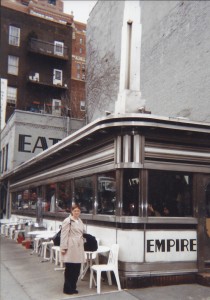
- Empire Diner (Fodero)
1999 photo by Glenn Wells
The red bands on the 1950s upper façade were repainted black and white (greatly improving the diner’s appearance, in my view), EAT was painted on the wall of an adjacent building in lettering matching that on the diner, and a skyscraper model was installed on the roof corner. The inside was modified in ways that ordinarily would make a diner purist cringe – the ceiling was painted black, track lights were added, and the table tops were overlaid with black Plexiglass. Nonetheless, the diner was a hit with the public and well-received within the diner enthusiast community as well, as evidenced by the fact that renowned diner artist John Baeder did a painting of the renovated Empire.
All was well until 2010 when things turned ugly, to say the least. Proprietor Renate Gonzalez was evicted and the diner was leased to a new operator. A fight ensued over the name Empire Diner, resulting in the new operator using the name Highliner Diner. The skyscraper model on the roof went missing. The interior was renovated, including the addition of a communal table. But the Highliner didn’t have all that long a life, closing at the end of 2012.
Now reopened under “celebrity chef” Amanda Frietag, the Empire has received another round of renovations. The ceiling is now white, probably a more appropriate color for a diner ceiling than black. There’s new booths and stools with backs, and it looks like the counter is shorter than it once was. But the Fodero winged clock is still there, and plans are to resume 24 hour operation once again.
Salem Diner, 70 1/2 Loring Avenue, Salem, Massachusetts
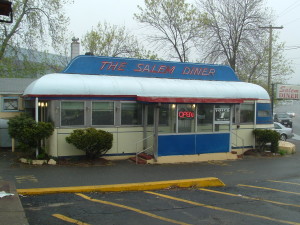
- Salem Diner (Sterling)
2006 photo by Glenn Wells
The Salem Diner is one of only two Sterling Streamliners still operating (the Modern Diner in Pawtucket, RI is the other one.) Recently acquired by Salem State University, the diner is operated by Chartwells, its food service operator. A similar arrangement exists at the Savannah College of Art and Design, where two diners – the Streamliner (Worcester) and Bobbie’s Diner (Mountain View) – are operated by the college’s food service operator.
Regular diner hours are Monday through Saturday from 6 a.m. to 3 p.m. and 8 p.m. to 11 p.m., and Sunday from 7 a.m. to 2 p.m. and 8 p.m. to 11 p.m. Those 8 to 11 nighttime hours seem geared toward students needing a late night snack.
Izzy’s Diner and Pizza (formerly Miss Adams Diner), 53 Park Street, Adams, MA
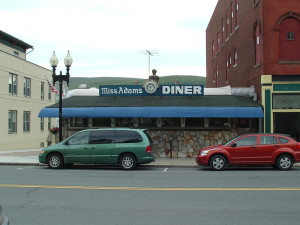
- Miss Adams Diner (Worcester),
2009 photo by Glenn Wells
The Miss Adams Diner, Worcester Lunch Car number 821, was delivered to Adams in 1949, replacing an older diner (still in use as Claudette’s 1921 Diner in Boylston, MA.) The diner received much favorable attention in the 1990s under the ownership of Barry and Nancy Garton (who today operate Brew Ha Ha in North Adams), but after they left, ownership of the diner was assumed by Boston restaurateur Jae Chung who leased the diner to a long succession of tenants, none of whom seemed to last very long. Then in 2005 – wrongly surmising the building was the problem – Chung undertook a “remodeling” which consisted of covering the original Worcester Lunch Car woodwork with shiny metal and stapling records to the ceiling, giving the place an artificial “retro 1950s” look. (One might say that with a 1949 Worcester Lunch Car they already had the real thing.)
By 2010 Chung had lost ownership of the diner and Steepleview Realty leased it to Philomene and Ric Belair, who ultimately were unable to come to terms to purchase the diner. Today, Izzy’s Diner and Pizza operates out of the old Miss Adams, run by Rick “Izzy” Solomon and Annmarie Belmonte. It’s the second time behind that marble counter for Belmonte – she was the last person to operate the Miss Adams under Chung’s ownership. And if a pizza joint isn’t your idea of the best use of a diner, take heart in the fact that meatloaf and lumberjack breakfast sandwiches are among the best sellers. They are even open for dinner, rare for a diner in New England!
Parkway Diner, 1696 Williston Road, South Burlington, Vermont
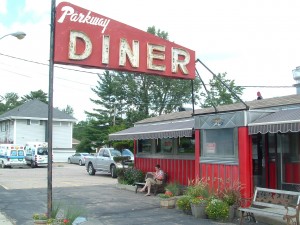
- Parkway Diner (Worcester)
2012 photo by Glenn Wells
Due to a lease issue, this diner dropped out of the orbit of northern Vermont diner mogul William Maglaris (who had renamed it the Arcadia Diner.) It’s the Parkway Diner again, now operated by Corey Gottfried. This diner highly impressed me on my one visit in 2012 – even with the Arcadia name. Manufactured near the end of the Worcester Lunch Car Company’s long run (# 839), this diner sports stainless steel trim on the outside – an attempt to keep up with the New Jersey manufacturers – but inside, there’s still varnished wood trim and cooking behind the counter.
The Diner (formerly Sullivan’s Diner), 59 Old Ithaca Road, Horseheads, NY
The Irish name Sullivan fit well with the original green tile and trim of this 1940s Silk City diner. So, what happens when the diner is taken over by a Yankees fan – one who wants to put his mark on the place? Sullivan green gives way to Yankees blue, and original Silk City tile work on the counter and floor is lost. The two views below show how Sullivan’s looked in 2008. Now, click here to see some photos of how it looks now.
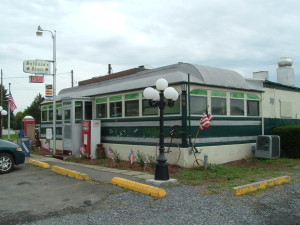
- Sullivan’s Diner (Silk City),
2008 photo by Glenn Wells
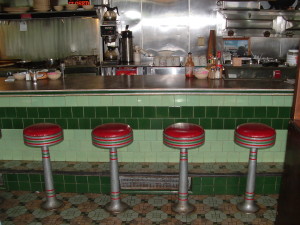
- Sullivan’s Diner counter
2008 photo by Glenn Wells
Katz Club Diner, 1975 Lee Road, Cleveland Heights, Ohio
If one vintage diner is good, then two have to be better, right? You might want to consider the history of this diner pair in Cleveland Heights before answering. Originally the Zephyr Diner (O’Mahony) from Berwick, Pennsylvania and the Terminal Diner (Mountain View) from Atlantic City, both diners received a meticulous restoration at Steve Harwin’s Diversified Diners before opening in Cleveland Heights as Dottie’s Diner and the Sweet City Diner. By the time of my visit in 2006, ownership had changed and they were Chris’ Diner and Jimmy’s Diner. Next it was Clyde’s Bistro, and the interior of the Mountain View was gutted. Now the Katz Club Diner, the O’Mahony has received some renovations that take it farther away from its original O’Mahony look, covering the original terrazzo floor with tile and replacing the booths with tables. Here’s two views of the O’Mahony from 2006 (when it was Chris’ Diner). Now, click here for a news article with a picture of how the interior looks now.
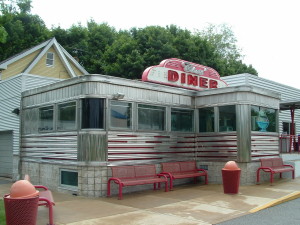
- Chris’ Diner (O’Mahony)
2006 photo by Glenn Wells
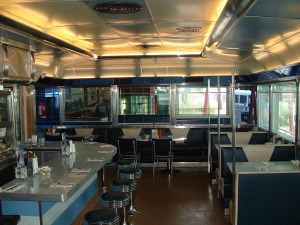
- Chris’ Diner interior
2006 photo by Glenn Wells
-
July 8, 2012
A diner by any other name…
Favorite Places

UPDATE: The Arcadia Diner closed on August 27, 2013 according to a posting on their Facebook page, citing a “huge increase in our monthly rent” as the reason for the closing. We hope this pristine Worcester Lunch Car reopens soon, and a return to the Parkway Diner name would be nice as well.
Whenever a vintage diner changes ownership, diner fans hold their breath. And when one owner acquires several diners, we tend to expect the worst. This happened in Philadelphia, where the landmark Mayfair and Melrose Diners were remodeled by a new owner, damaging their vintage charm in the process.
So it’s with this in mind that I had been observing the diner scene in Burlington, Vermont, where William Maglaris had been acquiring diners and rebranding them with Greek-sounding appellations. Libby’s Blue Line Diner (Worcester # 838) became the Athens Diner, and the Parkway Diner (Worcester # 839) became the Arcadia, an oval with the new name added over the top of “Parkway” on the original diner sign.
But on my recent visit, the original Parkway lettering was back in view, spurring me to ask the cashier some questions. The Arcadia sign ran afoul of sign regulations and the “historic” Parkway sign needed to remain, although the cashier said they were still trying to change it.
“Oh, so you’re still trying to call it the Arcadia Diner?” I said.
“We’re not trying to call it the Arcadia Diner. It is the Arcadia Diner!”
But here’s the good news: None of this makes a bit of difference. The diner’s interior gleams as though it had just left the Worcester Lunch Car factory, with beautiful tile and varnished wood trim. Cooking is still done behind the counter here, with a unique plate pass-through at a spot where it looks like one counter stool is missing. The food itself is a delight as well. My bacon was thick, crisp, and flavorful, accompanied by home fries made from large chunks of fresh potatoes. Constant Companion gave thumbs up to her spinach omelet, made with cheddar cheese.
So, the Parkway Diner sign might remain the way it is, or perhaps be replaced someday by one which reads Arcadia. Either way, it’s just a name. A diner, by any other name, is just as tasty.
Arcadia Diner
1696 Williston Road South Burlington, VT 05403
(802) 651-9080
